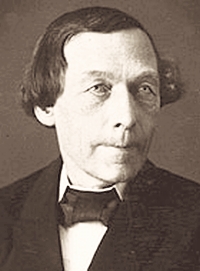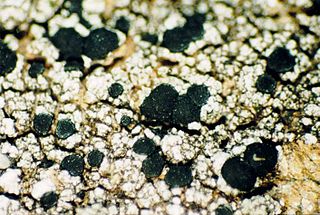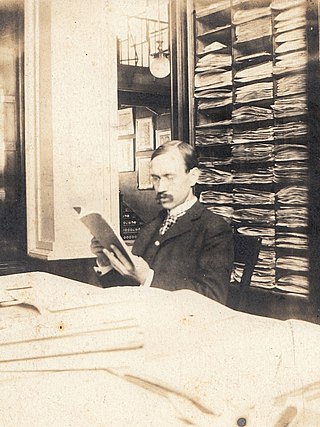Related Research Articles

William (Wilhem) Nylander was a Finnish botanist and entomologist. Nylander was born in Oulu, and taught at the University of Helsinki before moving to Paris, France, where he lived until his death in 1899.
Charles Christian Plitt was a botanist and lichenologist. Species of lichens that have been named in Charles Plitt's honor are: Pyrenula plittii R.C.Harris, Xanthoparmelia plittii (Gyelnk) Hale, and Pertusaria plittiana Erichsen.

Irwin Murray Brodo is an emeritus scientist at the Canadian Museum of Nature, in Ottawa, Ontario, Canada. He is an authority on the identification and biology of lichens.

The Lecanoraceae are a family of lichenized fungi in the order Lecanorales. Species of this family have a widespread distribution.

Hypogymnia is a genus of foliose lichens in the family Parmeliaceae. They are commonly known as tube lichens, bone lichens, or pillow lichens. Most species lack rhizines that are otherwise common in members of the Parmeliaceae, and have swollen lobes that are usually hollow. Other common characteristics are relatively small spores and the presence of physodic acid and related lichen products. The lichens usually grow on the bark and wood of coniferous trees.
Chicita Frances Culberson was an American lichenologist.
Aino Marjatta Henssen, was a German lichenologist and systematist. Her father, Gottfried Henssen, was a folklorist and her mother was Finnish.

William Louis "Bill" Culberson was an American lichenologist.
George Knox Merrill was an American lichenologist. He was a leading exponent of lichenology in the early 20th century. He was particularly interested in species of the family Cladoniaceae, in which he published several new species, varieties, and forms. In 1909 he started publishing the series Lichenes Exsiccati, which he continued intermittently until 1927; more than 400 specimen items were presented in two exsiccata series.
Mason Ellsworth Hale, Jr. was one of the most prolific American lichenologists of the 20th century. Many of his scholarly articles focused on the taxonomy of the family Parmeliaceae. Hale was one of the first lichen experts to incorporate secondary chemistry and technology such as computers and scanning electron microscopy into taxonomic work. Mason Hale published approximately two hundred articles and books on various aspects of lichen biology including taxonomy, anatomy, chemistry, and ecology. Hale also wrote several books aimed at education and increasing accessibility to lichens.

Abel Joel Grout (1867–1947) was an American bryologist, an expert on pleurocarpous mosses, and founding member of the Sullivant Moss Society.
Wilfred "Wilf" Borden Schofield (Botanist) was a Canadian botanist, specializing in mosses and liverworts. He was considered by many "the foremost bryologist in Canada".
Thomas Hawkes Nash III is an American lichenologist. His research is about the biology and ecology of lichens, and the effects of air pollution on plants and lichens. He is known as an authority on the family Parmeliaceae. During his long career at the Arizona State University, he helped develop the lichen herbarium into a world-class collection with over 100,000 specimens representing more than 5000 species. In 2010, the year of his retirement, he was awarded the Acharius Medal for lifetime achievements in lichenology, and the following year had a Festschrift published in his honor.
Gintaras Kantvilas is an Australian lichenologist, who earned his Ph.D in 1985 from the University of Tasmania with a thesis entitled Studies on Tasmanian rainforest lichens. He has authored over 432 species names, and 167 genera in the field of mycology.
Per Magnus Jørgensen is a Norwegian botanist and lichenologist, and Professor Emeritus of systematic botany at the University of Bergen. He is known for his work on the lichen families Pannariaceae and Collemataceae. Jørgensen was awarded the Acharius Medal in 2021 for his lifetime contributions to lichenology.
Robert "Bob" Shaw Egan is a botanist and lichenologist, specializing in the family Parmeliaceae. He was the president of the American Bryological and Lichenological Society from 1999 to 2001.
Bruce Pettit McCune is an American lichenologist, botanist, plant ecologist, and software developer for analysis of ecological data.
Marie-Agnès Letrouit-Galinou is a French botanist, mycologist, and lichenologist, known for her contribution to revolutionizing the scientific understanding of ascomycete development and classification.
Rosmarie Honegger is a Swiss lichenologist and Emeritus Professor at the University of Zurich.

Robert Lücking is a German lichenologist, known for his extensive research on foliicolous lichens and his significant contributions to the taxonomy, ecology, and biodiversity of fungi and lichens. He earned his master's and PhD from the University of Ulm, focusing on foliicolous lichens. He has received numerous awards for his work, including the Mason E. Hale Award for his doctoral thesis, the Augustin Pyramus de Candolle prize for his monograph, and the Tuckerman Award twice for his publications in the scientific journal The Bryologist.
References
- ↑ Thomson, John W. (1940). "Relic Prairie Areas in Central Wisconsin". Ecological Monographs. 10 (4): 685–717. Bibcode:1940EcoM...10..685T. doi:10.2307/1943556. ISSN 0012-9615. JSTOR 1943556. (abridgment of Thomson's 1939 Ph.D. thesis, 123 pages)
- 1 2 3 4 5 Ahti, Teuvo (2009). "A tribute to John Walter Thomson (1913–2009)". The Lichenologist. 41 (6): 561–563. doi: 10.1017/S0024282909990508 . ISSN 0024-2829.
- 1 2 Bennett, John (March 10, 2009). "Lichenologist John Walter Thomson (1913–2009)". Botanical Electronic News (405).
- 1 2 Cochrane, Theodore S. (April 2009). "In Memoriam: John Walter Thomson 1913 – 2009". Wisconsin Flora (Newsletter of the Botanical Club of Wisconsin): 1–3. reprinted in: Cochrane, Theodore S. (April 2009). "In Memoriam: John W. Thomson". The Great Lakes Botanist: A Journal of North American Botany. 48 (2): 61–62.
- 1 2 Gilchrist, Susan Cantrell (2013). "Interview: John Walter Thomson and Olive (Sherman) Thomson". Views of the Ridge: Oral Perspectives from the Military Ridge Prairie Heritage Area in Southwest Wisconsin (PDF). Wisconsin Department of Natural Resources. pp. 197–203.
- ↑ Henderson, Rich (Spring 2009). "Remembering a Conservation Leader and Educator" (PDF). The Prairie Promoter. 22 (1). The Prairie Enthusiasts: 3–4.
- ↑ Itasca Biological Station and Laboratories, College of Biological Sciences (February 20, 2015). "About Itasca". University of Minnesota.
- ↑ "Lichens". Wisconsin State Herbarium.
- ↑ "Lichenes Wisconsinenses exsiccati: IndExs ExsiccataID=165012480". IndExs – Index of Exsiccatae. Botanische Staatssammlung München. Retrieved 21 September 2024.
- ↑ "Lichenes Arctici: IndExs ExsiccataID=515968978". IndExs – Index of Exsiccatae. Botanische Staatssammlung München. Retrieved 21 September 2024.
- 1 2 "Olive Thomson WCGF Nominee Passes". The Wisconsin Conservation Hall of Fame. September 24, 2017.
- ↑ Enerson, D. E. (1980). "In memoriam. Douglas E. Thomson, M.D.". Radiology. 135 (3): 798. doi:10.1148/radiology.135.3.6992202. ISSN 0033-8419. PMID 6992202.
- ↑ "Thomson Memorial Prairie". The Nature Conservancy.
- ↑ "Schurch-Thomson Prairie". The Prairie Enthusiasts.
- ↑ "Acharius Medallists". International Association for Lichenology. Archived from the original on 2021-06-24. Retrieved 2021-02-03.
- ↑ Hawksworth, D. L. (July 1999). "Review of Lichenographia Thomsoniana: North American Lichenology in Honour of John W. Thomson, edited by M. G. Glenn, R. C. Harris, R. Ding and M. S. Cole". The Lichenologist. 31 (4): 403. doi:10.1006/lich.1999.0214. ISSN 0024-2829.
- ↑ "John Thomson Award". Botanical Club of Wisconsin.
- ↑ International Plant Names Index. J.W.Thomson.